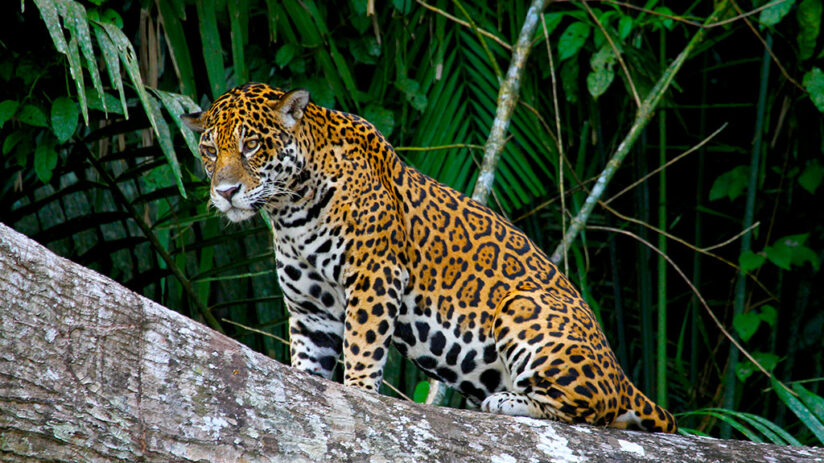The Amazon Rainforest in Peru is part of the largest rainforest in the world, just after Brazil. This jungle occupies 60% of the Peruvian territory and borders the Andes mountain range. More than 500 hectares of biodiversity on each shore of the Amazon River makes it in the lung of the planet. It is not surprising that Peruvian jungle territory is one of the areas with the greatest biodiversity and endemic species on the planet; 559 species of mammals, 469 species of reptiles, 623 amphibians species, and 4857 bird species. Some of these species in the rainforest are known and feared for their dangerousness. And these animals can be a real danger to humans. For this reason, together with the experts from Machu Travel Peru, we have prepared a small article about these animals. Learn about the most deadly and recognized jungle predators in Peru.
Some of the most popular jungle predators specimens
- Cataloging of animal species in the world
- Jaguar (Otorongo)
- Cayman (Black crocodile)
- Anaconda
- Piranhas
- Harpy Eagle
- River Otter
- Electric Eel
Cataloging of animal species in the world
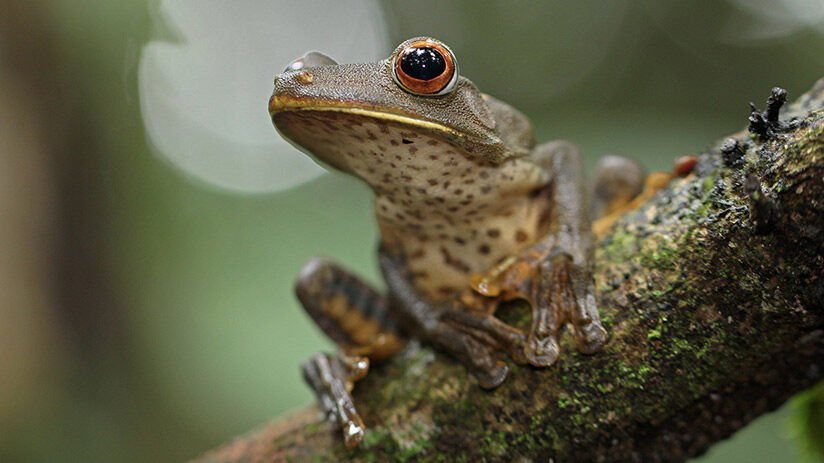
The IUCN (International Union for Conservation of Nature) cataloged the state of earth species in 7, going from least to more:
1.- Least-concern species (LC): species that are not in danger of extinction now or soon.
2.- Near-threatened species (NT): these species can be endangered soon.
3.- Vulnerable (VU): this means that the species here are at a high level of extinction in their wildlife. Unless the factors that threaten their reproduction and survival improve.
4.- Endangered (EN): Definitely, these species will be extinct in a particular zone or region. Due to foreign species, habitat loss, or poaching.
5.- Critically endangered (CR): These species afront a high level of extinction around the world (Without area distinctions) soon.
6.- Extinct in the wild (EW): Species that are extinct in their wildlife. A few survive in captivity areas.
7.- Extinct (EX): The end of the species around the world, both in wild and/or known areas and in places of captivity.
Jaguar (Otorongo)
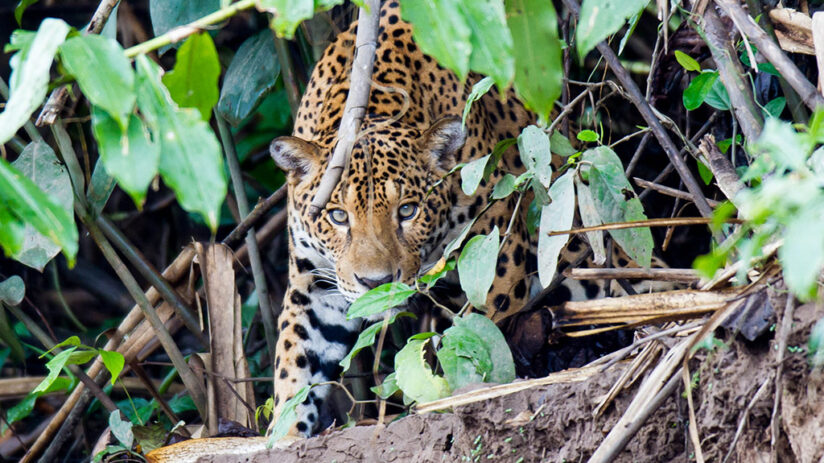
- Extinction status: Near threatened species (NT)
- Where to see them: Manu National Park, Tambopata, and Pacaya Samiria National Reserves.
- Condition: Super predator (Predator that hunts other predators)
- Chances to see: Occasionally. Stalking their prey behind bushes and riverbanks.
Ocelote in Central America, Otorongo in Peru, Jaguar in Paraguay. This feline lives through all the Amazon Rainforest of America and receives different names.
The Jaguar is one of the most difficult jungle predators to spot on a Peruvian Amazon tour. It can be occasionally seen on some boat trips as it lurks along the coast. It is one of the largest cats on the American continent (The third around the world and one of the four known species of the genus Panther). As you can imagine, it is a carnivorous feline that stands out for being a born hunter. Jaguars feed on large and small mammals to other reptiles of different sizes. Dawn and dusk hours are the preferred for the haunting and their diet consists of tapirs, peccaries, and other species that dominate the region.
They can be seen chasing prey such as the capybara, monkeys, sloths, wild boars, cattle inter alia. In addition to being excellent hunters on the ground, they are comfortable in the water. It has been seen hunting other aquatic jungle predators such as alligators and the surprising anaconda.
The creation of National Parks in different jungle regions has contributed to the preservation of this feline.
Cayman (Black crocodile)
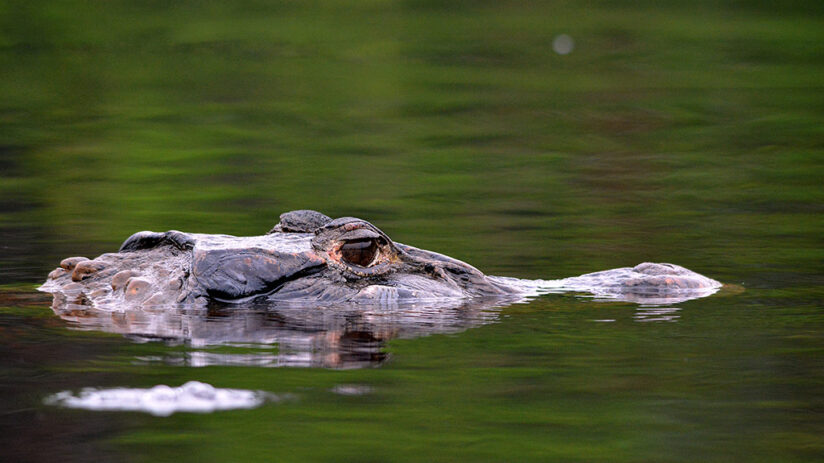
- Extinction status: Least-concern species (LC)
- Where to see them: Pacaya-Samiria and Tambopata National Reserve and Manu national park.
- Condition: Super predator (Predator that hunts other predators)
- Chances to see: Frequently. They are usually quiet for hours on the banks of the rivers or show their heads over the river level.
The Cayman is another of the most dangerous Peruvian animals found in the Amazon. It is a distant relative of the renowned American crocodile. In the Peruvian Amazon, there are numerous varieties of alligators and these are one of the most frequently sighted jungle predators. Both black alligators and spectacled alligators are the easiest to spot. While the other species are much more reserved.
The black caiman is the largest of all Peruvian jungle predators. This can reach 6 meters in length and is almost entirely black. Therefore, it is one of the largest crocodiles in the world. He is a born swimmer and tireless hunter with surprising intelligence. Its hard jaw of him provokes terror in those animals that are unlucky enough to cross it. Their diet consists of small mammals, birds, and fish. But it can also be seen eating other animals such as deer, wild boar, and monkeys. Although they have also been seen to include other jungle predators in their diets, such as anaconda, even other caimans.
Anaconda
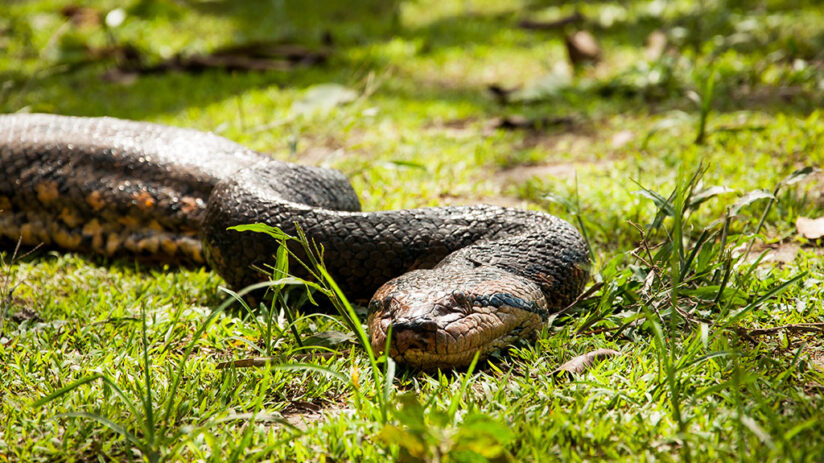
- Extinction status: Near threatened species (NT)
- Where to see them: Tambopata National Reserve and Manu National Park.
- Condition: Super predator (Predator that hunts other predators)
- Chances to see: infrequent. Unfortunately. The Anaconda hides under the murky waters of the rivers of the Amazon and can be there for hours.
The terrifying Anaconda belongs to the constrictor family and it is approximately 20 feet (6 meters) long and can weigh up to 300 pounds (140 kilograms) The largest in the world! Due to its size, it is quite clumsy on land, but in the water it can move much faster, dominating other known jungle predators.
The Anacondas are generally quiet and subtle, spending most of their time in the dark waters of the river. They often wrap their bodies around their prey and then drag it into the water which means that they drown them to death and then digest them whole. Even, It is known that they can eat from other jungle predators like wild pigs, alligators, and even jaguars! Happily, Anacondas do not usually eat that frequently either, a large meal is capable of lasting months.
If you are looking to spot this fascinating creature, you may need more than just a good expert guide, because they can be quite under rivers, difficult to detect and see them. Although these specimens can be found in regions of the Peruvian Amazon, their sighting is not guaranteed. With patience and some luck, you will be lucky enough to catch a glimpse of one of these snakes in the Amazon rainforest.
Piranhas
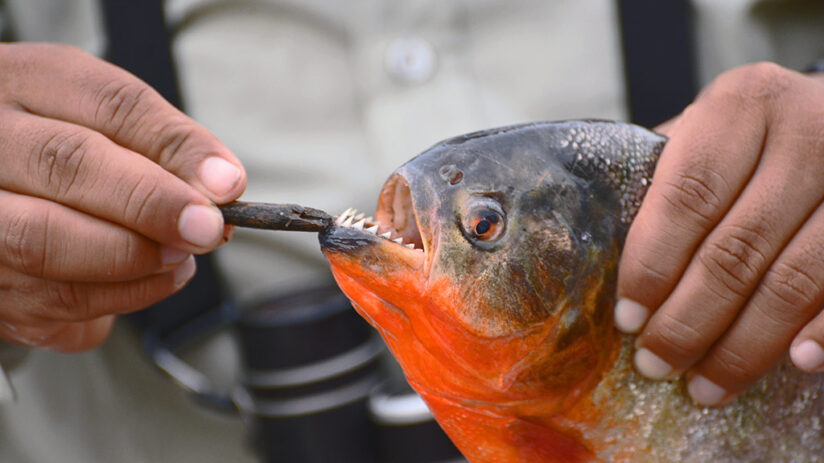
- Extinction status: Least-concern species (LC)
- Where to see them: Manu National Park and Pacaya Samiria National Reserve.
- Condition: Predators.
- Chances to see: Rarely. Piranhas inhabit the depths of the black waters of the Amazon. They can be seen if they are attracted to a hook, but it is better not to disturb them.
There is strength in numbers. The Piranhas or Caribeñas (nickname given in Venezuela) are carnivorous fishes that live in the Amazon River. These jungle predators belong to the broad Sawtooth subfamily, which includes herbivorous species. They could be considered medium-sized fish. They generally measure between 15 and 25 centimeters in length, although the length of the registered specimen can exceed 35 centimeters.
Despite their fame and popularity, piranhas hardly attack humans. It is worth mentioning that they are not as fierce as they are usually portrayed in certain movies. Yes, they are very gluttonous predators. It is characteristic of them to have sharp teeth and a voracious appetite. However, they are scavengers, this means that they eat dead or decomposing animals, and rarely attack live animals (except in drought seasons where food is food!)
It is very common for these jungle predators to attack in groups, and they can swallow mammals and birds in a few minutes. During your vacations in Peru, it is not very likely that you will see these fish, but you will hear about them.
Harpy Eagle
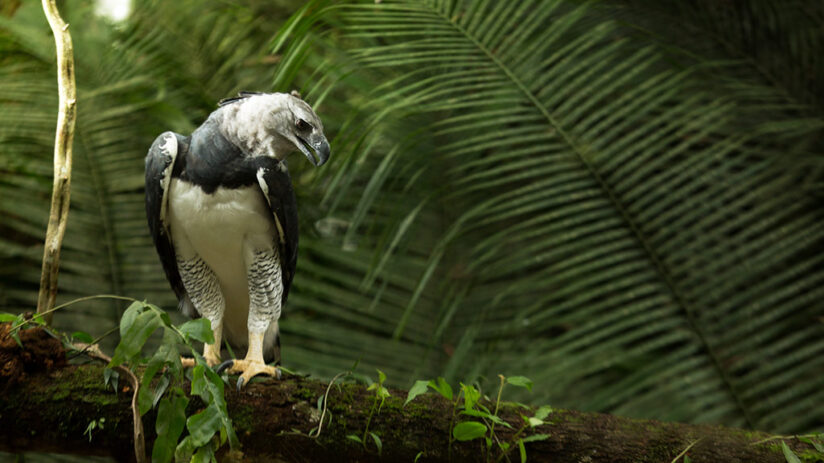
- Extinction status: Least-concern species (LC)
- Where to see them: Tambopata National Reserve.
- Condition: Super predator (Predator that hunts other predators)
- Chances to see: Infrequent. These animals nest high in the trees. That is why it is very difficult to see them among the foliage, branches, and leaves.
Another perhaps lesser-known jungle predator is the harpy eagle. This eagle is also known as the “king of the jungle canopy”. While the Jaguar rules the forest floor, the Anaconda is the king of the swamps, and the Harpy Eagle dominates the jungle canopy. Hence, his distinguished nickname. This eagle is the largest raptor in the Amazon Rainforest and one of the largest eagles in the world. The claws of the harpy eagle can grow to about 13 centimeters or 5 inches long. With its large claws, it is capable of catching its different prey.
There have been no known cases of these jungle predators hunting humans, although with their size and strength they would be capable of capturing children. But as it needs large areas of the Amazon Rainforest, it is increasingly difficult to spot. Unless the Canopy lookout towers, these centers are located in Tambopata National Reserve and offer the possibility of seeing these jungle predators flying over the trees and rainforest, searching for prey. Amazing!
The diet of this bird consists of mammals such as monkeys, and sloths. Although it has also been seen eating macaws, toucans, and small deer! These birds are truly intimidating due to their huge claws and large beak.
River Otter
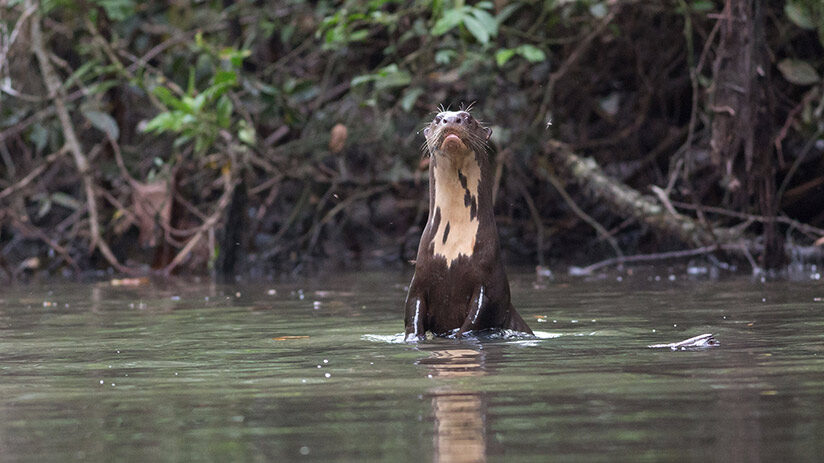
- Extinction status: Endangered species (EN)
- Where to see them: Manu National Park and Tambopata National Reserve.
- Condition: Predator.
- Chances to see: Frequently. These animals are diurnal and playful among them. You will see them over dry logs in the middle of the river, and wetlands on the river banks.
Among the jungle predators of the Amazon, the giant river otter is the more friendly species with humans. However, they are very territorial if someone invades their space, therefore, if you find some, try to keep a regular distance from them. The giant River Otter can measure up to 1.80 meters and weighs between 22 and 45 kilos.
These diurnal jungle predators live in families; are very cooperative and playful. It is known that they make different kinds of sounds to indicate alertness, relaxation, and danger. Their habitat is the deeps of the rivers, some dry logs in the middle of the rivers, and the wetlands on the river banks. Their diet is characins (piranhas), catfishes, and crabs.
Unfortunately, these jungle predators are endangered because they were excessively hunted in the middle of the sixties and seventies (By their fur). Besides, their zones of habitat are disappearing bit by the action of human advance. If you were looking for things to do in Iquitos, spotting this bird may be one of them.
Electric Eel
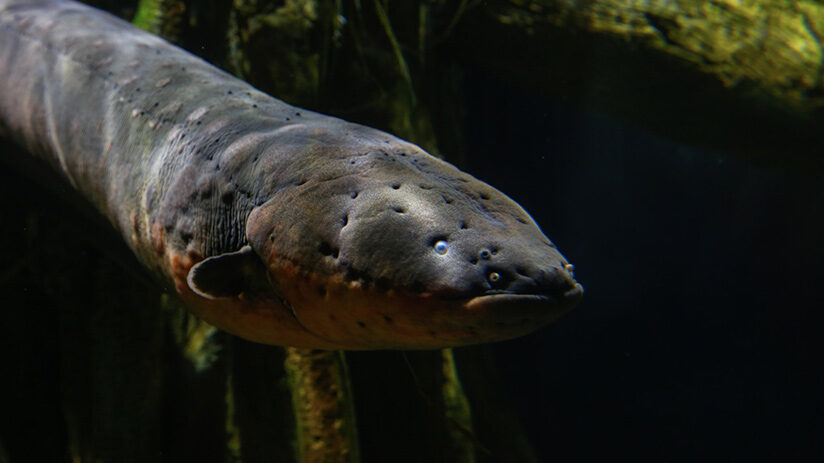
- Extinction status: Least-concern species (LC)
- Where to see them: Manu National Park and Tambopata National Reserve.
- Condition: Predator.
- Chances to see: Rarely. Fortunately, these jungle predators live in the deeps of the rivers and the farthest tributaries of the Amazon River.
Strictly speaking, the Electric Eel is not an eel. On the contrary, it is a fish, belonging to the Gymnotidae family of fish. These kinds of jungle predators remain unknown, for the most part, to science. However, we know that living throughout all rivers and tributaries of Peru Amazon. These can measure up to 1.8 meters and weigh 20 kilos. Now, let’s get to the most important thing, electricity.
Until 2019, it was known that Electric Eel could produce up to 600 volts of electricity to stun their prey, render it immobile (cardiorespiratory arrest), and after swallowing it slowly at the bottom of the river (Its diet is made up of small fish, insects, crustaceans, worms, and mollusks). However, since 2019 we know a special type of these jungle predators that can produce more than 850 volts in one attack, unbelievable!
But, rest assured, this kind of eel lives in the deeps of the Brazilian Amazon. Besides, If you want to know, their electric power comes from three pairs of organs located behind their brains. Science still studies the cells that form them. Until now, reports of attacks on humans are scarce. But, just imagine receiving a shock of more than 850 volts!
“WILD ANIMALS ARE LESS WILD AND MORE HUMAN THAN MANY HUMANS OF THIS WORLD”
As you will see, the Peruvian jungle predators of Peru are not as many as the great biodiversity it offers. In the same way, there are other predators within the Amazon in general that are not usually seen within Peruvian regions. Despite this, some of these mentioned predators can be quite difficult to spot. But don’t let this put you off! If you have a good guide by your side and with a bit of luck, you will most likely spot at least some of these jungle predators. Together with the Machu Travel Peru team, we hope we have been helpful. If you want to know more about our tours within the Peruvian Amazon, you can consult with our qualified advisors. They will be happy to help you plan the trip of your dreams!
